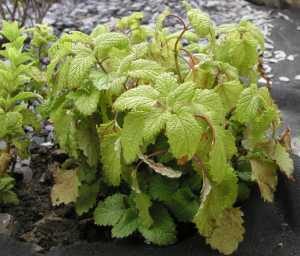How to Grow Lemon Balm – A Guide to Growing Lemon Balm
 Lemon balm AKA Sweet Balm or just Balm (Melissa Officinalis) is one of those herbs that has fallen down the popularity charts for some reason. Introduced to Britain by the Romans it was, by the middle ages, a fixture in any monastery garden and to be found in near every garden by the 17 th century.
Lemon balm AKA Sweet Balm or just Balm (Melissa Officinalis) is one of those herbs that has fallen down the popularity charts for some reason. Introduced to Britain by the Romans it was, by the middle ages, a fixture in any monastery garden and to be found in near every garden by the 17 th century.
Culpepper states “This herb is so well known to be an inhabitant in every garden, that I shall not need to give any description thereof, although the virtues thereof, which are many, should not be omitted.“
As a culinary herb it adds to fish and poultry dishes. It is used to make a tea which is said to help relaxation and sleep as well as cure colic, vomiting and indigestion.
Lemon balm is attractive to bees – the name Meliss coming from the Greek for Honey Bee.
Growing Lemon Balm
Lemon Balm can be grown from seed, root division or cuttings. Like many herbs it is tolerant but prefers a sunny spot and fairly dry conditions.
It can grow up to 60cm high with a similar spread. Left to its own devices, it can, like mint, be quite invasive and for that reason some prefer to grow it in pots or with constrained roots – like mint again.
Generally it shouldn’t require feeding but if it appears sickly using a general liquid feed at about half the recommended rate for a month should perk it up.
Harvesting Lemon Balm
Generally pick leaves to use as required.
For drying or freezing pick before the plant flowers when the flavour is at its best.
Pests and Problems with Lemon Balm
Apart from its invasive habit and a dislike of being water logged, there are no special problems or pests to watch out for
Varieties of Lemon Balm
There are a number of cultivars of Melissa officinalis but they can be difficult to track down.
- M. officinalis ‘Citronella’
- M. officinalis ‘Lemonella’
- M. officinalis ‘Quedlinburger’
- M. officinalis ‘Lime’
- M. officinalis ‘Variegata’
- M. officinalis ‘Aurea’
Eating & Storing Lemon Balm
Freezing and drying are usual although it loses flavour by drying.
Lemon Balm tea is well known but the herb can be used to flavour milk as in the Spanish drink ‘leche perfumado con melisa’



